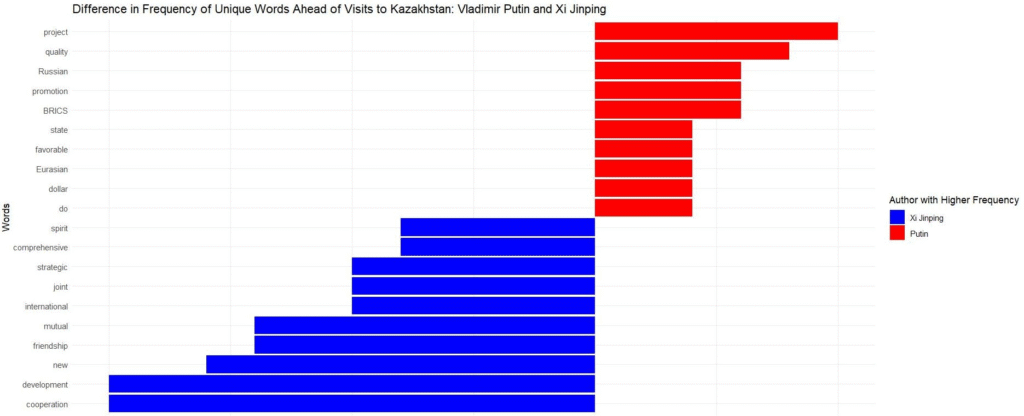China’s Growing Focus on Uzbekistan: Insights from Xi Jinping

Our R-based review of 2024 articles and speeches on Xi Jinping’s foreign policy shows clear patterns.
Kazakhstan dominates the narrative. Xi mentions it more than any other country because it anchors key Silk Road Economic Belt projects. Between 2013 and 2023 he visited four times, underscoring that priority.
References to Uzbekistan, Kyrgyzstan, and Tajikistan grow in 2023. The surge stems from coverage of the planned China–Kyrgyzstan–Uzbekistan railway and the China–Tajikistan highway corridor. Even so, the range of topics linked to Kazakhstan is broader. Pieces describe official deals, business ties, and everyday exchanges. One story, for example, features a Kazakh student at Hainan University who volunteers as a blood donor.
Xi also stresses Central Asia’s cultural wealth. He quotes poets writing in Kazakh and Tajik and repeats a popular Uzbek saying. By highlighting shared heritage, he strengthens China’s public-diplomacy appeal across the region.

Analysis of articles by Vladimir Putin and Xi Jinping prepared in the wake of official state visits to Kazakhstan offer intriguing insights into how both leaders approach public diplomacy in Central Asia.
Xi Draws on Putin’s Visit to Project a Cooperative Vision
On the eve of President Putin’s state visit to Kazakhstan, both he and President Tokayev published articles in Kazakh and Russian media. Putin’s rhetoric appeared to be noticeably narrower in scope compared to his earlier interviews, reflecting an emphasis on traditional markers of geopolitical alignment such as security alliances, exemplified by his frequent references to the CSTO.
In contrast, Tokayev’s approach highlighted the Shanghai Cooperation Organization and its role in maintaining stability, signaling an evolving bilateral dynamic. As Tokayev remarked during the visit, “We have very thoroughly, almost in unison, outlined all our approaches to the development of cooperation aimed at the future,” underscoring a convergence in economic, cultural, and energy interests despite previous challenges in the information sphere.
Xi Jinping’s approach, on the other hand, is markedly different. His article for Kazinform and broader communication strategy are built on terms such as “joint,” “mutual,” “development,” and “cooperation.” A frequency comparative text analysis using the R programming language confirms that these integrative terms appear far more frequently in Xi’s writings than in those of President Putin.
This deliberate linguistic choice reflects a forward-looking, inclusive narrative that distances China from the reactive, security-oriented rhetoric that has characterized Russian discourse. Moreover, by emphasizing non-interference and expressing support for Kazakhstan’s right to a self-chosen development path, Xi positions China as a respectful partner that values national sovereignty and stable regional growth.
Russia’s communications have traditionally relied on established security alliances and historical bonds, becoming more limited and reactive in scope. Chinese strategy, by contrast, represents an evolution in public diplomacy. Far from the ‘Wolf Warrior’ rhetorics often expected from Chinese diplomats, Xi Jinping emphasizes cooperative development, cultural resonance, and respect for sovereignty. This approach aims not only to strengthen China’s strategic presence in Central Asia but also to broaden its appeal to a diverse audience, crafting a narrative of mutual respect and shared destiny.

Sources: Kazinform and Kazakhstanskaya Pravda.
Summary
By weaving cultural references and shared heritage into his narratives, Xi not only deepens China’s soft‐power resonance but also constructs a public‐diplomacy message rooted in mutual respect and sovereignty. This stands in stark contrast to Russia’s traditionally security‐focused, alliance‐driven discourse, which appears narrower and reactive by comparison. Through repeated invocations of “joint,” “mutual,” “development,” and “cooperation,” Xi positions China as a forward‐looking partner eager to support indigenous paths to growth rather than impose strategic imperatives. Ultimately, this rhetorical and policy framework reinforces China’s strategic presence across the region, broadening its appeal beyond geopolitical calculation to include everyday cultural and economic ties that underpin a sustainable, mutually beneficial partnership.